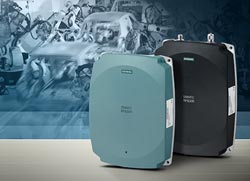Siemens optimizes UHF readers for use in industrial production

The readers use new algorithms to detect, read and write data storage media reliably, even in a difficult radio environment. This enables the Siemens UHF system to meet the specific requirements a production environment places on long-range, radio-based systems.
The Siemens Industry Automation Division is showcasing its Simatic RF620R and RF630R UHF readers which have been modified for industrial production. The new generation of devices incorporates functions which have been specially designed to meet the exacting requirements of a production environment. Industrial production plants present a difficult challenge to radio-based systems for a number of reasons: The readers are sometimes located very close together and may influence each other. There is also only a small distance between the workpiece holders and therefore between the transponders which have to be detected individually. Metal surfaces reflect the signals transmitted by the readers, which leads to superimposition of the radio waves and consequently radio fade-out. Apart from reflections, higher transmit powers can lead to overreach, so that the reading ranges of the individual readers overlap or the wrong data storage media are read out.
Siemens has designed functions for the new Simatic RF600 readers which overcome these difficulties. Process stability is substantially increased by an adaptive transmit power and intelligent filtering of the reading results. The adaptive transmit power ensures a high recognition rate because the reader automatically increases its power until it clearly detects at least one transponder in its RF field. This not only reduces radio frequency interference but also compensates for radio fade-out.
The multi-stage filter concept designed by Siemens uses the radio characteristics to ensure that the correct transponder in the RF field of a reader is always read or written. The appropriate data storage medium is automatically selected on the basis of various indicators, such as the evaluation of the RSSI value (Radio Signal Strength Indicator), the reading frequency or the transmit power required.
Various mechanisms can be activated according to requirements. The inventory threshold filter ensures that the transponders within range are initially observed for a short period of time before being identified. Transponders that have already been processed can be stored in a blacklist in the reader and thus be filtered out immediately. The “Tag Hold” function maintains communication between a selected transponder and the reader by utilizing the maximum transmit power. This ensures that data can be exchanged between reader and data storage medium even under difficult radio conditions.
The new RF620R and RF630R devices are being introduced in three hardware versions based on the following standards: ETSI for Europe, FCC for the USA and Canada, and CMIIT for China. Future firmware updates can be handled using the Step7 programming software.
The Siemens Industry Sector (Erlangen, Germany) is the worldwide leading supplier of environmentally friendly production, transportation, building and lighting technologies. With end-to-end automation technology and industrial software, solid vertical-market expertise, and technology-based services, the Sector enhances its customers' productivity, efficiency, and flexibility. With a global workforce of more than 100,000 employees, the Industry Sector comprises the Divisions Industry Automation, Drive Technologies and Customer Services as well as the Business Unit Metals Technologies. For more information, visit http://www.siemens.com/industry
The Siemens Industry Automation Division (Nuremberg, Germany) supports the entire value chain of its industrial customers – from product design to production and services – with an unmatched combination of automation technology, industrial control technology, and industrial software. With its software solutions, the Division can shorten the time-to-market of new products by up to 50 percent. Industry Automation comprises five Business Units: Industrial Automation Systems, Control Components and Systems Engineering, Sensors and Communications, Siemens PLM Software, and Water Technologies. For more information, visit http://www.siemens.com/industryautomation
Reference Number: IIA2012032911e
Contact
Mr. Peter Jefimiec
Industry Automation Division
Siemens AG
Gleiwitzerstr. 555
90475 Nuremberg
Germany
Tel: +49 (911) 895-7975
peter.jefimiec@siemens.com
Media Contact
More Information:
http://www.siemens.com/identAll latest news from the category: HANNOVER MESSE
Newest articles

First-of-its-kind study uses remote sensing to monitor plastic debris in rivers and lakes
Remote sensing creates a cost-effective solution to monitoring plastic pollution. A first-of-its-kind study from researchers at the University of Minnesota Twin Cities shows how remote sensing can help monitor and…

Laser-based artificial neuron mimics nerve cell functions at lightning speed
With a processing speed a billion times faster than nature, chip-based laser neuron could help advance AI tasks such as pattern recognition and sequence prediction. Researchers have developed a laser-based…

Optimising the processing of plastic waste
Just one look in the yellow bin reveals a colourful jumble of different types of plastic. However, the purer and more uniform plastic waste is, the easier it is to…



